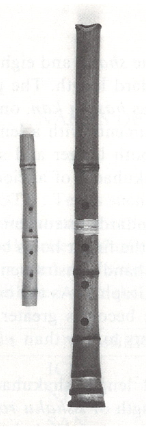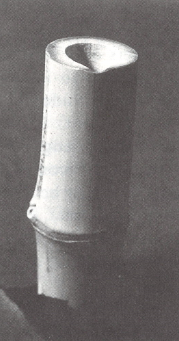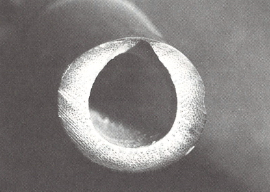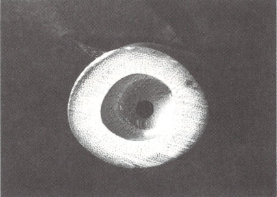quotation:The Encyclopedia of Musical Instruments the SHAKUHACHI
Tokyo Ongaku-sha Co.Ltd 1990
引用:楽器の事典 尺八
(株)東京音楽社 1990年発行
CHAPTER 1 : THE HISTORICAL
CLASSIFICATION OF THE SHAKUHACHI
The shakuhachi has been divided into four historical types :
1. The ancient shakuhachi -- Shōsōin shakuhachi
2. The medieval shakuhachi -- hitoyogiriri shakuhachi
3. The early-modern shakuhach -- komusō shakuhachi
4. The contemporary shakuhachi -- jinuri shakuhachi
The first is no longer played, and the second is played only within a very limited sphere. At present, the fourth is widely in use, and the third is also played to a lesser degree.
In Shōsōin in Nara, eight ancient shakuhachi have been preserved in perfect condition.They are estimated to be about 1200 years old. They are made from bamboo, stone, and ivory and even those made from bamboo use hachiku bamboo, not the madake bamboo that has been used from the Edo period onward to make the shakuhachi. Since they have all been designated as National Treasures, it is not possible to play them. We can construct reproductions that resemble them, but that does not allow us to know how the shakuhachi was played in that age. The ancient shakuhachi has 6 finger holes※ (see glossary), but the extra hole was not supplementary in nature ; rather, all the holes had the same function. This instrument was used to play a six tone scale. However, we cannot fully know the nature of this six tone scale and its music.
Since the shakuhachi was used to play gagaku, ensemble music of a grand scale, it is also called the “gagaku shakuhachi”. However, since gagaku was revised around the ninth century and the shakuhachi was no longer used in its performance, it gradually declined from that time onward. The term shakuhachi refers to the length of the instrument which is “one shaku, eight sun”. However, the length of the ancient shakuhachi used the measuring system of Tang China as the standard, so it is much shorter than the contemporary shakuhachi.
The medieval shakuhachi is also termed the “hitoyogiri shakuhachi” and as an abbreviation “hitoyogiri”. This term means that the bamboo body of the instrument has only one joint.This term is also used to refer to vases made of bamboo. The hitoyogiri has a standard length of one shaku, one sun, and one bu (about 33.6 centimeters). It is said that it was brought to Japan from China by Roan (Photograph 41-1) in the 15th century, but there is little evidence to support this. Because of the thickness of the bamboo, the angle of the utaguchi ※(one kind of mouthpiece, see glossary),and the depth of the finger holes, the hitoyogiri shakuhachi is not as versatile as that of today.
In the case of both the gagaku shakuhachi and the hitoyogiri shakuhachi, we do not know exactly when it flourished, in what circumstances it was played, or the extent of the region within which it was played. But since the hitoyogiri has five holes, it was clearly used to play music different from that of the gagaku shakuhachi.
From the medieval period onward, there was a type of shakuhachi termed the “tempuku shakuhachi,”which is still played today in one part of Kyūshū. The construction of its utaguchi is distinct from both the hitoyogiri shakuhachi and the contemporary shakuhachi.
In the photograph, the contemporary shakuhachi is compared with a tempuku shakuhachi, supplied by Fujio Kiyonobu and Endō Takeo.
Photograph upper-left : on the right is the contemporary shakuhachi.
Photograph upper-right : the utaguchi of the the tempuku shakuhachi.
Photograph lower-left : the utaguchi of the tempuku shakuhachi.
Photograph lower-right : the end of the tempuku shakuhachi.




The shakuhachi of the early-modern period is also called the komuso shakuhachi and the Fuke shakuhachi. Although nothing is known in detail, it is said that Master Fuke brought it from China arid that Master Kyochiku popularized it. komuso refers to the monks of the Fuke sect (see glossary and chapter 49). The Fuke used the shakuhachi as a ritual instrument. The monks did not play it as musical activity, but were a Zen sect that used the playing of the shakuhachi as an equivalent to the chanting of the sutras. The Fuke sect was abolished more than 100 years ago, but even after that the instrument and the music survived. The Tatchu-Meianji [also known as Myoanji or more correctl as Zennein],
located within the confines of Tofukuji [15-797 Honmachi, Higashiyama-ku,Kyoto] is a temple that was closely connected with the Fuke sect. Also, the temple Kokokuji [Yuracho, Hitaka-gun, Wakayama Prefecture]has had a long connect ion with the sect.
It is unclear how and when the distinct scale of the early modern shakuhachi was established. This is a pressing question which is significant for the history of Japanese music. In its appearrance this shakuhachi resembles very closely the contemporary one, but if one looks at the interior of the instruments, the differences between them are evident. The contemporary shakuhachi is termed the jinuri shakuhachi, because the inside is carefully treated with a mixture of water, lacquer (see glossary), polishing powder, and gypsum. Because of this process, the instrument vibrates well and the has a stable tone. More importantly, this makes it possible to play in a higher range known as daikan on(see glossary). As a result, the range of the shakuhachi is equivalent to that of the flute. This testifies to the transformation of the shakuhachi from a ritual instrument to a musical instrument.
Below in part two, we examine the manufacture of the jinuri shakuhachi, and begin to understand the process by which bamboo becomes a musical instrument, the instrument produces sound, and the sound creates a culture.
(glossary)
※FINGER HOLE is referred to as teana and shuko. The finger holes of the shakuhachi do not use mediating devices such as springs and levers, but rather are played directly with the finger tips. Therefore, the diameter of the holes is such that they can be easily pressed by the finger-tips, approximately 8-10 millimeters in size. Human skin is the best possible spring.
※UTAGUCHI refers to a kind of mouthpiece, that part of the instrument thatthe expelled air strikes. In the case of brass instruments, it is possible to distinguish between mouthpieces that easily produce high tones or low tones, or that produce a powerful or delicate sound. The performers of woodwind instruments too sometimes specially order a mouthpiece that is suitable for themselves. However, in the case of the shakuhachi, one does not switch the jokan. See Photograph 3 and REEDLESS INSTRUMENTS
quotation:The Encyclopedia of Musical Instruments the SHAKUHACHI
Tokyo Ongaku-sha Co.Ltd 1990
引用:楽器の事典 尺八
(株)東京音楽社 1990年発行


